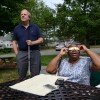The web—or, as we used to call it, the World Wide Web—is 25 years old this month. On August 6, 1991, Sir Tim Berners-Lee, who had outlined his idea for the web two years earlier, published the first website. It was, as the Telegraph put it, “a basic text page with hyperlinked words that connected to other pages.”
Those of us who were there at the beginning understood that this was a big deal. Even so, the revolution it launched could not have been imagined. As Virginia Heffernan put it in her recent book Magic and Loss: The Internet as Art, “The Internet is the great masterpiece of human civilization.” And the web provides the road map that makes the internet navigable.
In the early days of digital media I was what you might call a second-wave adopter, sampling cool stuff after the true pioneers had assured the rest of us that it was safe to enter. My first foray into online media came in 1986, when I was a reporter for Woburn's Daily Times Chronicle. I covered the federal trial made famous by the book and movie A Civil Action using an Apple IIc and a 300-bits-per-second modem.
A few years later I was a user of Boston CitiNet, a free bulletin-board system, or BBS, that provided text-based information of varying degrees of usefulness. And I wrote an article for the Boston Phoenix about what it was like to follow the 1992 election returns on Prodigy, an early online provider whose crude graphics were a step up from text-only services.
These early examples, though, were islands unto themselves, disconnected from the internet. CitiNet, as I recall, used something called Fido to send messages to other BBSs overnight, when usage was lower. I don’t think Prodigy let you communicate with anyone outside of Prodigy.
So it was a huge breakthrough when I was able to sign up for an internet account through Software Tool & Die of Brookline. Back then, you’d dial into a mainframe, which let you access various Unix-based text-only programs that existed out in the ether, such as email and Gopher. The latter was especially valuable—it was like a less flexible web in that you could move up and down gopher sites (get it?), but not back and forth, which meant that you had to drill through a series of menus to get to where you were going. But there was all kinds of data available on Gopher sites, most of which were part of academic institutions. I researched several stories using Gopher, including one for an environmental magazine called Garbage on the use of artificial growth hormone in cows.
At some point after Berners-Lee’s first website was published, a web browser known as Lynx became available. This was an improvement on Gopher because you could navigate across the internet more quickly. In fact, to this day I have never moved around the web as fast as I did with Lynx.
Then came, in 1993, came Mosaic—the first graphical web browser. I actually remember where I was the day that a colleague at the Phoenix told me she’d read about it in the New York Times.
The revolution had arrived.
I hardly need to tell you what came after. Today we are just beginning to grapple with the internet's cultural effects. We know all about what the web did to journalism, books, and the music business, of course. But now the web is transforming education, medicine, and even downtown business districts, as they load up on internet-proof restaurants while retail flees to Amazon.
The web’s 25th anniversary is a good time to ponder where we’ve been and where we’re going. And it’s an occasion to reflect on how utterly different the world is compared to 25 years ago. There was a time when the web didn’t exist, and there was a time when it was a place we'd visit. Now it’s just the way we live.
Correction: An earlier publication of this article incorrectly read "Back then, you’d dial into a mainframe, which let you access various Linux-based text-only programs that existed out in the ether, such as email and Gopher." Linux should read 'Unix', and the published copy now reads correctly.



